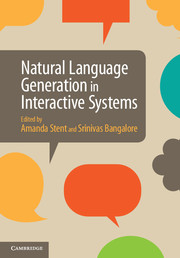Book contents
- Frontmatter
- Contents
- List of contributors
- 1 Introduction
- Part I Joint construction
- Part II Reference
- Part III Handling uncertainty
- Part IV Engagement
- 9 Data-driven methods for linguistic style control
- 10 Integration of cultural factors into the behavioral models of virtual characters
- 11 Natural language generation for augmentative and assistive technologies
- Part V Evaluation and shared tasks
- Author index
- Subject index
- References
10 - Integration of cultural factors into the behavioral models of virtual characters
from Part IV - Engagement
Published online by Cambridge University Press: 05 July 2014
- Frontmatter
- Contents
- List of contributors
- 1 Introduction
- Part I Joint construction
- Part II Reference
- Part III Handling uncertainty
- Part IV Engagement
- 9 Data-driven methods for linguistic style control
- 10 Integration of cultural factors into the behavioral models of virtual characters
- 11 Natural language generation for augmentative and assistive technologies
- Part V Evaluation and shared tasks
- Author index
- Subject index
- References
Summary
Introduction
The design and implementation of embodied virtual agents that converse with human users and/or other agents using natural language is an important application area for Natural Language Generation (NLG). While traditional NLG systems focus on information provision (the transformation of content from a knowledge base into natural language for providing information to readers), embodied conversational agents also need to exhibit human-like qualities. These qualities range from the integration of verbal and non-verbal communicative behaviors – such as facial expressions, gestures, and speech – to the simulation of social and emotional intelligence. To be believable, embodied conversational agents should not all show the same behavior. Rather, they should be realized as individuals that portray personality and culture in a convincing manner.
Whereas a number of approaches exist to tailor system behavior to personality (for example, see the approach by Mairesse and Walker (2008) for NLG and the approach by Hartmann et al. (2005) for gesture generation), few researchers have so far taken up the challenge of modeling the influences of culture on communicative behavior. Even when communication partners speak the same language, irritations and misunderstandings can arise due to cultural differences in what people say and how they say it. For example, Germans tend to get straight to business and be rather formal, while casual small talk is more common in the United States. As a consequence, Americans might perceive Germans as rather reserved and distant, and Germans might feel rather uncomfortable about sharing private thoughts with Americans they have just met.
Information
- Type
- Chapter
- Information
- Natural Language Generation in Interactive Systems , pp. 227 - 251Publisher: Cambridge University PressPrint publication year: 2014
References
Accessibility standard: Unknown
Why this information is here
This section outlines the accessibility features of this content - including support for screen readers, full keyboard navigation and high-contrast display options. This may not be relevant for you.Accessibility Information
- 3
- Cited by
